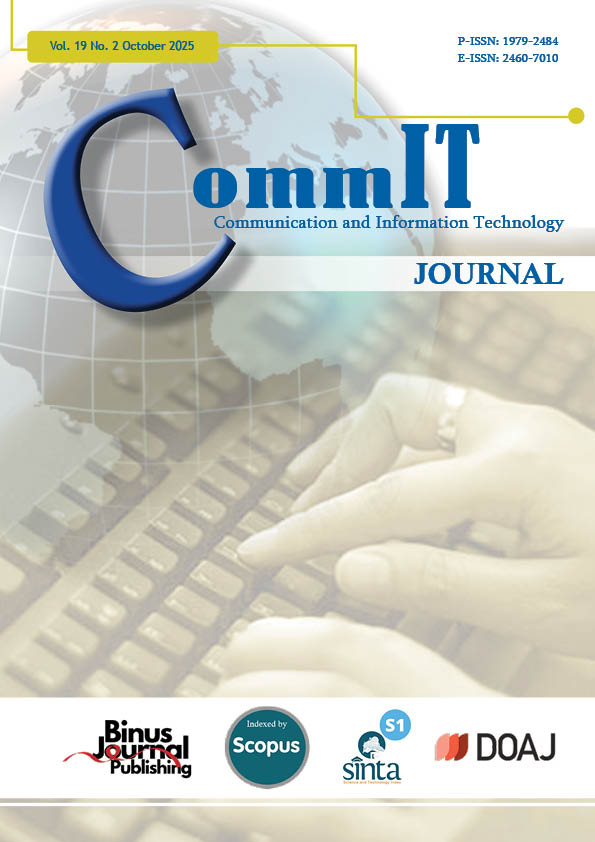Deep Learning Techniques to Enhance Energy Efficiency of Home Appliances by Analyzing Air Quality Levels
DOI:
https://doi.org/10.21512/commit.v19i2.14213Keywords:
Deep Learning, Home Appliances, Energy Efficiency, Air Quality Level (AQL)Abstract
Energy efficiency in home appliances is a critical area of research that addresses the growing demand for reducing energy consumption. The rapid growth in artificial intelligence has prioritized the development of advanced methods to improve sustainable energy consumption, particularly by optimizing the energy efficiency of home appliances. The research introduces a novel deep learning-based framework to enhance energy efficiency in home appliances by leveraging insights from Indoor Air Quality (IAQ) metrics. Unlike conventional energy management approaches, which face challenges such as limited datasets, computational inefficiencies, and a lack of generalizability, the research incorporates advanced preprocessing and augmentation techniques. Specifically, a hybrid Synthetic Minority Over-sampling Technique - Edited Nearest Neighbors (SMOTE-ENN) approach addresses class imbalance, while Z-score normalization ensures consistent feature scaling. Among the evaluated models, the Bidirectional Gated Recurrent Unit (GRU) and the Stacked Long Short-Term Memory (LSTM) stand out, achieving exceptional validation accuracies of 99.81% and 99.64%, respectively, demonstrating superior generalization. This framework uniquely integrates IAQ data to optimize energy usage dynamically, showcasing how environmental factors such as CO2, humidity, and temperature can inform sustainable energy practices. These findings underscore the transformative potential of deep learning in fostering ecofriendly innovations for smart home energy management. They show the broader potential for integrating artificial intelligence-driven approaches into energy policies and sustainability strategies, enabling more effective reductions in residential energy consumption and combating climate change.
References
[1] M. Santamouris and K. Vasilakopoulou, “Present and future energy consumption of buildings: Challenges and opportunities towards decarbonisation,” e-Prime-Advances in Electrical Engineering, Electronics and Energy, vol. 1, pp. 1–14, 2021.
[2] T. M. Olatunde, A. C. Okwandu, and D. O. Akande, “Reviewing the impact of energyefficient appliances on household consumption,” International Journal of Science and Technology, vol. 6, no. 2, pp. 1–11, 2024.
[3] U.S. Department of Energy, “Buildings & industry pillar.” [Online]. Available: www.energy.gov/eere/energy-efficiency-buildings-and-industry
[4] Energy Savers Network, “Simple home energy saving tips.” [Online]. Available: https://www.greenbuilt.org/energysaversnetwork/home-energy-saving-tips/
[5] W. Chen, M. Alharthi, J. Zhang, and I. Khan, “The need for energy efficiency and economic prosperity in a sustainable environment,” Gondwana Research, vol. 127, pp. 22–35, 2024.
[6] S. Karatzas, J. Merino, A. Puchkova, C. Mountzouris, G. Protopsaltis, J. Gialelis, and A. K. Parlikad, “A virtual sensing approach to enhancing personalized strategies for indoor environmental quality and residential energy management,” Building and Environment, vol. 261, pp. 1–13, 2024.
[7] A. Verma and Y. Kumar, “Study on machine learning based energy efficiency in developed countries,” in 2020 Fourth International Conference on I-SMAC (IoT in Social, Mobile, Analytics and Cloud) (I-SMAC). Palladam, India: IEEE, Oct. 7–9, 2020, pp. 895–899.
[8] A. Abobakirov and O. Omonboev, “Energy efficient building materials in the design of buildings and structures,” Holders Reason, vol. 1, no. 3, pp. 406–412, 2023.
[9] M. Khalil, A. S. McGough, Z. Pourmirza, M. Pazhoohesh, and S. Walker, “Machine learning, deep learning and statistical analysis for forecasting building energy consumption–A systematic review,” Engineering Applications of Artificial Intelligence, vol. 115, 2022.
[10] Y. Xiang, Y. Chen, J. Xu, and Z. Chen, “Research on sustainability evaluation of green building engineering based on artificial intelligence and energy consumption,” Energy Reports, vol. 8, pp. 11 378–11 391, 2022.
[11] S. Park, “Machine learning-based cost-effective smart home data analysis and forecasting for energy saving,” Buildings, vol. 13, no. 9, pp. 1–16, 2023.
[12] J. Khan, M. Fayaz, U. Zaman, E. Lee, A. S. Balobaid, S. Ali, and K. Kim, “A hybrid machine learning and optimization algorithm for enhanced user comfort and energy efficiency in smart homes,” 2024. [Online]. Available: https://doi.org/10.20944/preprints202401.1331.v1
[13] L. Shree, S. Manjunatha, V. Vekariya, G. D. Benal, and H. Patil, “Efficient optimization of energy consumption at home through machine learning,” in 2024 5th International Conference on Mobile Computing and Sustainable Informatics (ICMCSI). Lalitpur, Nepal: IEEE, Jan. 18–19, 2024, pp. 109–114.
[14] M. Khan, J. Seo, and D. Kim, “Towards energy efficient home automation: A deep learning approach,” Sensors, vol. 20, no. 24, pp. 1–18, 2020.
[15] Q. Liao, M. Zhu, L. Wu, X. Pan, X. Tang, and Z. Wang, “Deep learning for air quality forecasts: A review,” Current Pollution Reports, vol. 6, no. 4, pp. 399–409, 2020.
[16] R. R. Chowdhury, “Smart building system,” 2020. [Online]. Available: https://www.kaggle.com/datasets/ranakrc/smart-building-system
[17] P. P. Kasaraneni, Y. Venkata Pavan Kumar, G. L. K. Moganti, and R. Kannan, “Machine learning-based ensemble classifiers for anomaly handling in smart home energy consumption data,” Sensors, vol. 22, no. 23, pp. 1–20, 2022.
[18] Y. R. Yoon, Y. R. Lee, S. H. Kim, J. W. Kim, and H. J. Moon, “A non-intrusive data-driven model for detailed occupants’ activities classification in residential buildings using environmental and energy usage data,” Energy and Buildings, vol. 256, 2022.
[19] Y. Ding, L. Fan, and X. Liu, “Analysis of feature matrix in machine learning algorithms to predict energy consumption of public buildings,” Energy and Buildings, vol. 249, 2021.
[20] A. H. Alharbi, D. S. Khafaga, A. M. Zaki, E. S. M. El-Kenawy, A. Ibrahim, A. A. Abdelhamid, M. M. Eid, M. El-Said, N. Khodadadi, L. Abualigah, and M. A. Saeed, “Forecasting of energy efficiency in buildings using multilayer perceptron regressor with waterwheel plant algorithm hyperparameter,” Frontiers in Energy Research, vol. 12, pp. 1–16, 2024.
[21] C. Fan, J. Wang, W. Gang, and S. Li, “Assessment of deep recurrent neural network-based strategies for short-term building energy predictions,” Applied Energy, vol. 236, pp. 700–710, 2019.
[22] Y. Natarajan, S. P. K. R., G. Wadhwa, Y. Choi, Z. Chen, D. E. Lee, and Y. Mi, “Enhancing building energy efficiency with IoT-driven hybrid deep learning models for accurate energy consumption prediction,” Sustainability, vol. 16, no. 5, pp. 1–22, 2024.
[23] S. K. Singh, M. Kumar, S. Tanwar, and J. H. Park, “GRU-based digital twin framework for data allocation and storage in IoT-enabled smart home networks,” Future Generation Computer Systems, vol. 153, pp. 391–402, 2024.
[24] K. Attarde and J. Sayyad, “A CNN and BiLSTM fusion approach toward precise appliance energy forecasts,” International Journal of Intelligent Engineering & Systems, vol. 17, no. 3, pp. 199–212, 2024.
[25] D. Niu, M. Yu, L. Sun, T. Gao, and K. Wang, “Short-term multi-energy load forecasting for integrated energy systems based on CNN-BiGRU optimized by attention mechanism,” Applied Energy, vol. 313, 2022.
[26] M. A. Alghamdi, S. Abdullah, and M. Ragab, “Predicting energy consumption using Stacked LSTM snapshot ensemble,” Big Data Mining and Analytics, vol. 7, no. 2, pp. 247–270, 2024.
[27] T. Han, K. Muhammad, T. Hussain, J. Lloret, and S. W. Baik, “An efficient deep learning framework for intelligent energy management in IoT networks,” IEEE Internet of Things Journal, vol. 8, no. 5, pp. 3170–3179, 2020.
[28] I. Izonin, R. Tkachenko, S. A. Mitoulis, A. Faramarzi, I. Tsmots, and D. Mashtalir, “Machine learning for predicting energy efficiency of buildings: A small data approach,” Procedia Computer Science, vol. 231, pp. 72–77, 2024.
[29] L. D. Long, “An AI-driven model for predicting and optimizing energy-efficient building envelopes,” Alexandria Engineering Journal, vol. 79, pp. 480–501, 2023.
[30] K. Mayer, L. Haas, T. Huang, J. Bernab´e-Moreno, R. Rajagopal, and M. Fischer, “Estimating building energy efficiency from street view imagery, aerial imagery, and land surface temperature data,” Applied Energy, vol. 333, 2023.
[31] N. Kapoor and Y. Kumar, “The efficient managemnet of renewable energy resources for Vanet-Cloud communication,” in Nature-Inspired Computing Applications in Advanced Communication Networks. IGI Global Scientific Publishing, 2020, pp. 228–253.
Downloads
Published
How to Cite
Issue
Section
License
Copyright (c) 2025 Jasbir Singh Saini, Sunny Arora, Sushil Kamboj

This work is licensed under a Creative Commons Attribution-ShareAlike 4.0 International License.
Authors who publish with this journal agree to the following terms:
a. Authors retain copyright and grant the journal right of first publication with the work simultaneously licensed under a Creative Commons Attribution License - Share Alike that allows others to share the work with an acknowledgment of the work's authorship and initial publication in this journal.
b. Authors are able to enter into separate, additional contractual arrangements for the non-exclusive distribution of the journal's published version of the work (e.g., post it to an institutional repository or publish it in a book), with an acknowledgment of its initial publication in this journal.
c. Authors are permitted and encouraged to post their work online (e.g., in institutional repositories or on their website) prior to and during the submission process, as it can lead to productive exchanges, as well as earlier and greater citation of published work.
Â
USER RIGHTS
All articles published Open Access will be immediately and permanently free for everyone to read and download. We are continuously working with our author communities to select the best choice of license options, currently being defined for this journal as follows: Creative Commons Attribution-Share Alike (CC BY-SA)




















